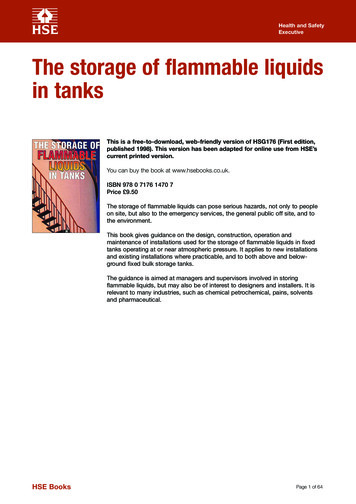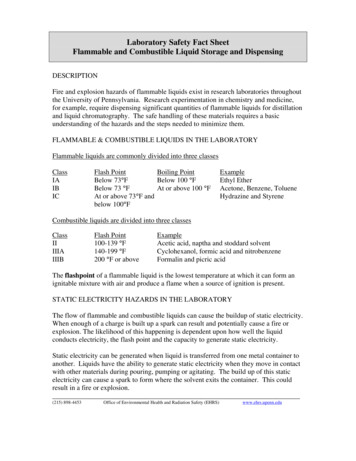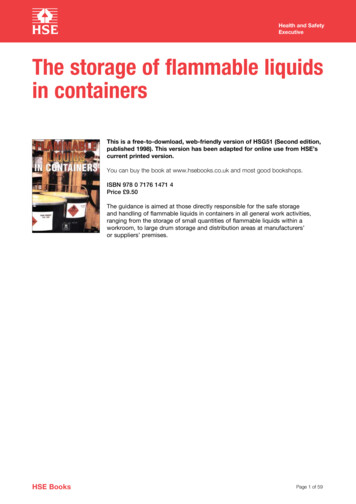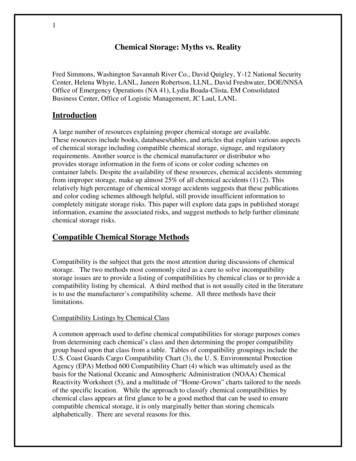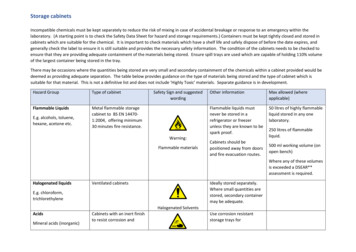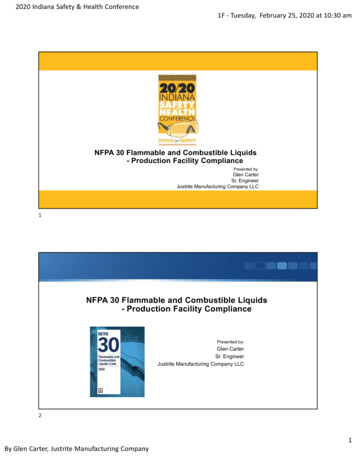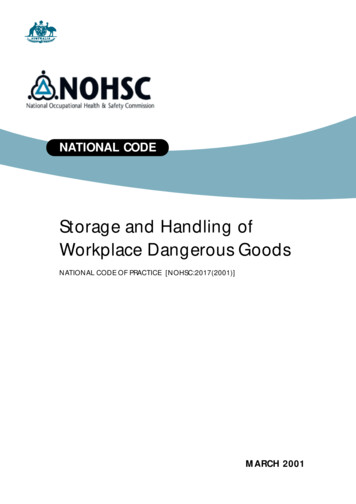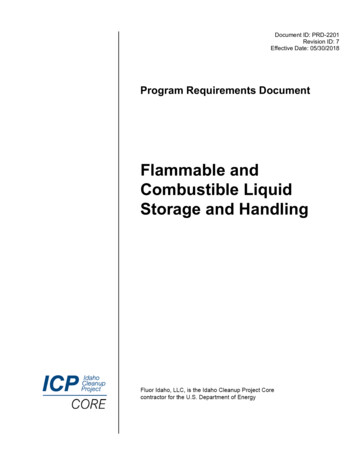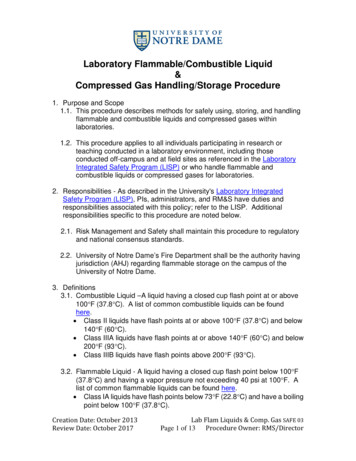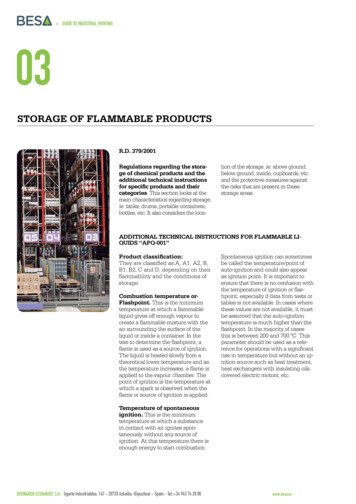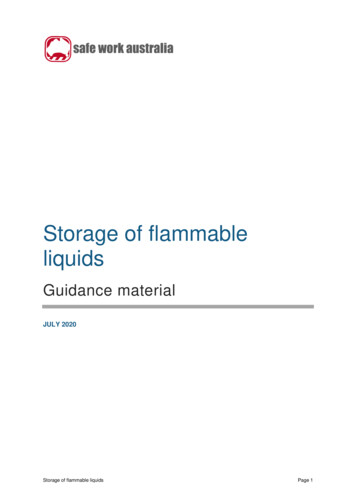
Transcription
Storage of flammableliquidsGuidance materialJULY 2020Storage of flammable liquidsPage 1
DisclaimerSafe Work Australia is an Australian Government statutory agency established in 2009. Safe Work Australia includes Membersfrom the Commonwealth, and each state and territory, Members representing the interests of workers and Membersrepresenting the interests of employers.Safe Work Australia works with the Commonwealth, state and territory governments to improve work health and safety andworkers’ compensation arrangements. Safe Work Australia is a national policy body, not a regulator of work health and safety.The Commonwealth, states and territories have responsibility for regulating and enforcing work health and safety laws in theirjurisdiction.ISBN 978-1-76051-943-8 (Online PDF)ISBN 978-1-76051-944-5 (Online DOCX)Creative CommonsWith the exception of the Safe Work Australia logo, this copyright work is licensed under a Creative Commons Attribution 4.0International licence. To view a copy of this licence, visit creativecommons.org/licenses In essence, you are free to copy,communicate and adapt the work for non-commercial purposes, as long as you attribute the work to Safe Work Australia andabide by the other licence terms.Contact informationSafe Work Australia info@swa.gov.au www.swa.gov.auStorage of flammable liquidsPage 2
ContentsContents . 3Introduction . 4Who should use this guide? . 4What are flammable liquids? . 4Risk management . 6Identifying hazards . 6Assessing risks . 9Eliminating risks . 9Substitution . 9Isolation. 10Engineering controls. 11Administrative controls . 12Reviewing and maintaining controls . 13Example . 14Placards . 15Storage of flammable liquidsPage 3
IntroductionWho should use this guide?If your business involves using, handling, generating or storing flammable liquids you mustmanage the risks to health and safety associated with those liquids to protect both yourworkers and others at the workplace.This guide provides practical advice for businesses that store small quantities of flammableliquids. You should seek specialist advice if you store large quantities of flammable liquids(i.e. manifest quantities) or are unsure about how to manage risks at your workplace.Be aware that you must ensure that flammable liquids are kept at the lowest practicablequantity for the workplace.In this guide, the word ‘must’ indicates a legal requirement that must be complied with. Theword ‘should’ indicates a recommended course of action.This guide is intended tosupplement other information available from Safe Work Australia and should be read inconjunction with: the model Code of Practice: How to manage work health and safety risksthe model Code of Practice for Managing risks of hazardous chemicals in theworkplace, andthe Managing risks of storing hazardous chemicals in the workplace guide.If you require assistance when designing and implementing the controls outlined in thisguide, for example designing storage rooms, spill containment or ventilation systems, youshould seek specialist advice.This guide does not include information about requirements for containers in whichflammable liquids are stored, or about requirements for labelling of containers. Furtherinformation about requirements for containers and labelling can be found in the model Codeof Practice for Labelling of Workplace Hazardous Chemicals.What are flammable liquids?Common examples of flammable liquids are fuels, solvents and thinners, alcohols, oil-basedpaints and resins.Flammable liquids are classified according to the Globally Harmonized System ofClassification and Labelling of Chemicals (GHS) when stored and used in workplaces, andthe Australian Dangerous Goods code (ADG code) when transported. Classifying chemicalsincludes placing them into categories which reflect the severity of their hazard. You can oftenidentify flammable liquids by the presence of warnings (as shown below) on their labels andin their safety data sheets.The classification of a flammable liquid is determined by its flash point (the temperature atwhich it will will ignite) and its boiling point (because chemicals with lower boiling points tendto produce more vapour).Storage of flammable liquidsPage 4
Table 1: GHS Category, ADG Class/packing group and associated label elementsCriteriaFlash point 230C, initialboiling point 350CFlash point 230C, initialboiling point 350CFlash point 230C and 600CFlash point 600C and 930CGHS Category1234GHS PictogramNo pictogramGHS SignalWordDangerDangerWarningWarningGHS HazardStatementsExtremelyflammable liquidand vapourHighly flammableliquid and vapourFlammable liquidand vapourCombustibleliquidADG class andpacking group(PG)Class 3: PG IClass 3: PG IIClass 3: PG IIIN/AADG class labelStorage of flammable liquidsNo class label asthis is not adangerous good.Page 5
Risk managementThis section sets out a step-by-step process for identifying, assessing and controlling therisks associated with storing flammable liquids. It prioritises higher order controls, such aseliminating hazards. These controls are more reliable and must always be used wherepossible, over less effective controls such as signage and training.Be aware that this guide provides only general advice about controlling the risks associatedwith small quantities of flammable liquids. Some specialised controls, such as using fullyautomated handling systems and inert atmospheres, are not discussed in this guide. If youidentify other, more effective risk controls for your business you should use them wherereasonably practicable.More information about the risk management process, including how to identify hazards andassess risks can be found in the guide Managing risks of storing chemicals in the workplace,the model Code of Practice: How to manage work health and safety risks and model Code ofPractice: Managing risks of hazardous chemicals in the workplace.Consult your workers throughout the risk management process.Having workers participate in discussions about health and safety is important. They arelikely to know about the risks of their work and have an interest in keeping safe. You mustconsult with them to help you identify hazards and assess risks, and you should ask for theirsuggestions about managing those risks.Getting workers involved will also help get staff on board with any changes that need to bemade. It is best to keep staff involved throughout the process, let them know what’schanging and why.More information on consulting with workers can be found in the model Code of Practice:Work health and safety consultation, cooperation and coordination.Identifying hazardsYou must begin your risk management process by identifying hazards (that is, things andsituations that could potentially cause harm to people).Flammable liquids are a common source of fuel for fires and explosions, because theyproduce flammable vapour and ignite at low temperatures. Many fires start when flammableliquids are spilt or their containers are left open, and their vapours reach an ignition sourcesuch as an open flame.Fire and explosion can result when the following three elements come together (commonlyreferred to as the fire triangle): a source of fuel (a flammable or combustible substance)a source of oxygen (usually in the air), andan ignition source (a source of energy sufficient to cause ignition).Storage of flammable liquidsPage 6
Figure 1: The fire triangle Take stock of your flammable liquidsThe first step in managing risks associated with flammable liquids is to identify which typesare stored at the workplace, and in what volumes. A list of hazardous chemicals used at yourworkplace and their current safety data sheets must be available in your workplace’shazardous chemical register. However, it may also be useful to manually check your storageareas to see what they hold. Identify other fire risk materialsFlammable and combustible material should also be considered when managing the risks ofa fire. These include items like wood or paper, which can easily ignite and increase the riskof a fire, and increase the fuel available in a fire.If you have other fire risk materials, such as gas cylinders, aerosol spray cans and somefertilisers, you should also identify them in this step. Identify ignition sourcesAn ignition source can be any energy source that has the potential to ignite a fuel. You mustidentify any ignition source in your workplace that has the potential to ignite flammable orcombustible material.Examples of ignition sources are provided in the table below; you should refer to this listwhen assessing ignition sources at your workplace.Storage of flammable liquidsPage 7
Table 2: Examples of possible ignition sources in the workplaceType of ignition sourceExamplesFlamePropane and oxy-acetylene torches, gas heaters, pilot lights,cigarette lighters.SparkWelding arcs, starters for fluorescent lighting, electric motors,electrical equipment like power points, switches and mobilephones. Static electricity, including from friction sources.Lightning, friction from drilling, grinding, scraping of metal onconcrete.HeatHot surfaces including light bulbs, ovens, radiators orheaters, flue pipes, vehicle engines and exhaust systems,pumps and generators. Exothermic chemical reactions (thosewhich generate heat). Vapour clouds and hazardous areasPlaces where flammable gases, vapours, dusts, fumes and mists are likely to be present inthe air in a flammable or explosive concentration are hazardous areas.Flammable liquids can create clouds of flammable vapour when exposed to the air, eitherthrough open containers, pouring, mixing, or from a spill or leak. This vapour is invisible andcan build up quickly. If an ignition source, such as a spark or open flame, is introduced intothe area it may cause a fire or explosion. Even small quantities of flammable liquid cancreate a vapour cloud that can travel considerable distances and flashback to its point ofgeneration if it meets a source of ignition. This is particularly the case when decanting or ifthe liquid is spilt.You must identify any area where flammable vapours are likely to be present in yourworkplace. In general, where flammable liquids are stored in small quantities hazardousatmospheres should not result, provided that adequate ventilation is provided. In any case,you should ensure that ignition sources are not present in areas where flammable vapoursmay accumulate.Chemicals in GHS Flammable Liquid Category 4, unlike other flammable liquids, do notordinarily give rise to flammable vapours unless they are heated. This means they are lesslikely to ignite, but will provide fuel for a fire if one starts.EXPERT HELPThe assessment of hazardous areas is a complex process that needsspecialist knowledge. If you believe a hazardous area is present at yourworkplace it is recommended that you engage a specialist to help youassess and manage the risks it poses.Storage of flammable liquidsPage 8
Figure 2: Stored flammable liquids may create hazardous vapoursAssessing risksOnce you have identified hazards you need to consider the associated risks (that is, whatcould happen if someone is exposed to those hazards, and the likelihood of it happening). Ifyou already know the risks, and how to control them effectively, you may simply implementthe controls.Controls that must be applied to manage the risks of flammable liquids are set out below.Eliminating risksYou must always begin by eliminating risks where it is reasonably practicable, as this is themost effective way to stop an incident from occurring. Dispose of any unnecessary flammable liquids. This includes flammablewaste chemicals and chemicals which you no longer need. Ensure thatflammable liquids are disposed of in accordance with local waste disposalrequirements. Dispose of combustible materials. Excess combustible material, like wood orpaper, can act as fuel for a fire. Limit the amount of flammable liquids you store. Limiting your hazardouschemicals to only those you require, and buying products only as you need them,helps eliminate the risks posed by flammable liquids.SubstitutionIf it is not possible to eliminate a flammable liquid from your workplace the risk must beminimised so far as is reasonably practicable. To minimise the risk, consider substituting itfor a less hazardous alternative.Storage of flammable liquidsPage 9
Substitute flammable liquids with non-flammable alternatives. Such as byusing nails instead of chemical adhesives. Substitute highly flammable liquids for less flammable liquids. Such as byusing a water-based ink instead of a solvent-based ink.When substituting chemicals it’s important to carefully consider whether new chemicals haveother hazards that need to be managed in different ways.IsolationPhysically separate flammable liquids from people, ignition sources and other hazards tominimise the risks of a fire. Store your chemicals away from workers and other hazards. Chemicals arebest stored away from normal work areas to reduce the risk of any accidentalspills or damage of hazardous chemicals. For example, don’t store them:o where vehicles will be operatingo in thoroughfares or near exits, oro in the same area as food or personal belongings. Separate flammable chemicals from ignition sources. If a flammable liquid orits vapour cloud comes into contact with an ignition source a fire will occur. Thefollowing steps should be taken to remove ignition sources:o choose a chemical storage location that is away from any ignition sourcesthat cannot easily be removed (such as pilot lights)o eliminate any ignition sources near the chemical storage (for example, installnon-sparking lights)o do not allow ignition sources to be introduced to the flammable liquid storageareao do not allow hot work (grinding, heating, welding etc.) near the flammableliquid storage areas, ando store flammable liquids in a flammable liquids cabinet where practicable. Separate incompatible chemicals. This can be done by separating chemicalswithin the same storage area (segregation) or by storing incompatible chemicalsin separate storage areas.More information about separating chemicals can be found in Managing risks of storingchemicals in the workplace guide. As a general guide, the following separation distances arerecommended between flammable liquids and other hazardous chemicals.Storage of flammable liquidsPage 10
Table 3: Recommended separation distances between flammable liquids and other hazardous chemicalsTypes of ChemicalSeparation distanceOther hazardous chemical such as gases underpressure and corrosive chemicalsMinimum three metres separationOther fire risk chemicals such as flammablegases, pyrophoric chemicals, self-heatingchemicals and oxidisers*Minimum five metres separationHighly reactive chemicals such as self-reactivechemicals, organic peroxides and explosivesshould be in completely separate storage areasIsolate completely*flammable solids can typically be stored with three metres of separationSeparating incompatible chemicals can also include the use of barriers, such as flame-proofcabinets.You should also refer to the safety data sheet for each hazardous chemical you store formore information about its storage requirements. Safety data sheets should be stored inyour workplace hazardous chemical register and may be obtained from the manufacturer,importer or supplier of the chemical.Engineering controlsConsider which engineering controls, if any, could further control the risks. Note that not allof the controls described here will be suitable for every business.Engineering controls are built into the design of plant, equipment or processes to minimisetheir hazards. Engineering controls are a very reliable way to control worker exposures aslong as the controls are designed, used and maintained properly.EXPERT HELPEngineering controls are a very reliable way to control the risks ofhazardous chemicals as long as they are designed, used and maintainedproperly. If you are unsure about how to use engineering controls at yourworkplace, consider engaging a specialist to help you assess and managethe risks it poses.Key engineering controls that should be considered for the storage of flammable liquids are: Bunding and drainage. Bunding and spill trays should be in place (separationdistances should be measured horizontally from the edge of any spill containmentsystem). Incompatible chemicals should never share the same bunding ordrainage systems, and liquids should not be stored above solids. Informationabout incompatabilities can be found on the safety data sheets for yourchemicals.Storage of flammable liquidsPage 11
Ventilation. Design storage areas with sufficient natural ventilation somechanical ventilation is not needed, or consider mechanical ventilation toextract flammable vapours that may accumulate. The design, installation and useof ventilation systems is discussed in depth in the model Code of Practice:Managing risks of hazardous chemicals. Intrinsically safe electrical equipment. Intrinsically safe electrical equipmentmeans equipment which cannot produce a spark capable of starting a fire. Ifthere is an area where a flammable vapour may be present, only intrinsically safeequipment should be used within it. This includes ensuring that any lighting orfittings is intrinsically safe. A hazardous area classification can help identifywhere this kind of equipement is required (see page 6). Earthing and bonding to manage risk of static electricity. Static electricitycan be created from a range of activities including the transfer of flammableliquids. Accumulation of static electricity may lead to a spark igniting flammablevapours. Enclosed transfer systems with vapour recovery connections. Usingenclosed transfer systems (rather than splash filling containers) can reduce theamount of flammable vapour produced when flammable liquids are transferredfrom one vessel to another. Fire-fighting and fire protection systems. If your workplace has a risk of fire,you must install fire-fighting equipment and fire protection systems. You mustconsider the types and quanties of chemicals used, handled and stored whendeciding on the firefighting equipment and fire protection systems. These caninclude:o alarms and smoke detectorso fire extinguisherso fire doors and fire rated barriers, ando automated fire control systems such as sprinklers.Administrative controlsAdministrative controls must be used to provide additional protection, if any risk remainsafter implementing substitution, isolation and engineering controls. Examples ofadministrative controls for flammable liquids include: Written rules and procedures for using and storing flammable liquids. Forexample:o keep lids open only for the period required for transfero minimise exposed surface areaso avoid splash filling containerso minimise the temperature of liquids being transferred, ando clean up leaks and spills immediately using a spill kit. Training. For example:o how to safely use, store and handle flammable chemicals, andStorage of flammable liquidsPage 12
ohow to respond to a fire (i.e. use a fire extinguisher, evacuate, contactemergency services). Signage. For example:o signs at the entrance to storage areas warning workers and others not tointroduce ignition sources.Reviewing and maintaining controlsRisk controls are not ‘set and forget’ measures. Care must be taken to ensure they remaineffective. Be prepared and organise: A storeroom inspection schedule. The Managing risks of storing hazardouschemicals in the workplace guide has a checklist of what you should include. Maintenance and testing schedule for engineering controls, includingsafety equipment. Manufacturers should be able to provide information onrecommended frequency of inspection, maintenance and testing. Maintenance isessential to ensure that engineering controls, such as mechanical ventilation andintrinsically safe electrical equipment, continue to operate effectively. Regular staff training. This should include inductions for new workers, and caninclude regular safety talks and refreshers for ongoing staff.When reviewing controls, it is important to ask if anything has changed since the controlswere put in place. For example, if you are now storing different chemicals they may need tobe segregated differently, or the latest safety data sheet may contain new information. Youshould consult with your staff to help you identify any new or changed hazards, and any riskcontrols that are not operating effectively.For more information on storing hazardous chemicals see the Managing risks of storinghazardous chemicals in the workplace guide.Storage of flammable liquidsPage 13
ExampleA spray-painting shop stores various paints and an organic solvent for equipment cleaningand paint thinning. The manager of the shop reviews the chemical’s safety data sheets,which are kept in the shop’s hazardous chemical register. He learns the following about thechemicals they store: The paints stored at the workplace can ignite, but do not sustain combustion. Despitethis, they are still capable of creating a flammable vapour cloud if the containers areleft open or a spill is not cleaned up.The solvent used is highly flammable. While only small quantities of the solvent areneeded at any one time, larger quantities are often kept on site so that it does notneed to be reordered regularly.The spray-painting shop has a dedicated storage area where the paints and solvents arekept. A second, dedicated work area is used for thinning and mixing paints. No portableignition sources (e.g. radio or fans) are allowed to be brought into the dedicated work area,or close to the dedicated work area. While there is fixed electrical equipment in the area (e.g.stirrer) it is rated as intrinsically safe in accordance with the relevant Australian Standard.The storage area and work area have ventilation systems in place to remove any vapoursthat might accumulate if flammable liquids are spilt or their containers are left open.Any flammable waste chemicals generated at the shop are stored overnight prior to disposalby a local waste company. There have been no reported spills in the past 12 months and nofires have occurred. Smoking is prohibited and that procedure is strictly adhered to.Result: To supplement the existing controls, the manager decides to: Keep only small quantities of the solvent on site. The manager decides to buysmaller quantities more often, rather than buying and storing large quantities.Ensure the solvents and flammable liquid waste are stored in a lockable, flame-proofcabinet.Schedule another review in 12 months time.Storage of flammable liquidsPage 14
PlacardsPlacards are special signs required at some workplaces under work health and safety laws.You must display placards if you store hazardous chemicals above the placard quantitieslisted in the Placard and manifest requirements under the model Work Health and SafetyRegulations, or if you store hazardous chemical in bulk (in containers that hold more than500 litres or kilograms).For flammable liquids, the placard quantites are: Category 1 flammable liquids – 50 litresCategory 2 flammable liquids – 250 litresCategory 3 flammable liquids – 1,000 litresCategory 4 flammable liquids – 10,000 litresPlacards are also required if the combined quantitiy of category 1, 2 and 3 flammable liquidsstored at the workplace exceeds 1,000 litres, even if the flammable liquids do not exceedtheir individual placard quantities.Specific placard requirements are set out in Schedule 13 to the model Work Health andSafety Regulations, but have been summarised below.Outer warning placardsOuter warning placards are required if the quantity of hazardous chemicals at the workplaceexceeds the placard quantity. An outer warning placards must be located at each entranceto the workplace that may be used by emergency services and must look like this:Figure 3: Outer warning placards dimensionsPlacards for hazardous chemicals in packages or intermediate bulk containers(IBCs)Placards for hazardous chemicals in packages or IBCs are required if the quantity ofhazardous chemicals stored at the workplace exceeds the placard quantity.If category 1, 2 or 3 flammable liquids are stored in packages (containers that hold 500 litresor less) or IBCs, placards must be displayed: at the entrance to any store room or storage area where the liquids are stored, andat the entrance to any building in which the liquids are stored.Package and IBC storage placards for category 1, 2 or 3 flammable liquids look like this:Storage of flammable liquidsPage 15
Figure 4: Package storage placard for Category 1, 2 or 3 flammable liquidsIf you store only category 4 flammable liquids, the placard shown below is used instead:Figure 5: Package storage placards for Category 4 flammable liquidsOther package storage placards may also be required, depending on the other hazards ofchemicals stored in the same building. The placards at the entry to the store will only includethe class labels of the chemicals in that store that exceed the relevant placard quantity.Placards for hazardous chemicals stored in bulkIf hazardous chemicals are stored in a bulk container (a container that holds more than 500kilograms or litres, but not an IBC), placards must be placed on or adjacent to the containerregardless of the total quantity of the hazardous chemical in the workplace. The placard forhazardous chemicals stored in bulk looks like this:Figure 6: Bulk storage placards for hazardous chemicalsThe placard must include the following information, as specified in the ADG code: in space (p)—the proper shipping name for the hazardous chemicalin space (q)—the UN Number for the hazardous chemicalin space (r)—the Hazchem Code for the hazardous chemicalStorage of flammable liquidsPage 16
in space (s)—the class label and subsidiary risk label for the hazardous chemicalNote that if you are storing a category 4 flammable liquid in bulk, the combustible liquidplacard (see Figure 5 above) must be placed on or adjacent to the container instead.Storage of flammable liquidsPage 17
Places where flammable gases, vapours, dusts, fumes and mists are likely to be present in the air in a flammable or explosive concentration are hazardous areas. Flammable liquids can create clouds of flammable vapour when exposed to the air, either through open containers, pouring, mixing, or from a spill or leak. This vapour is invisible and
